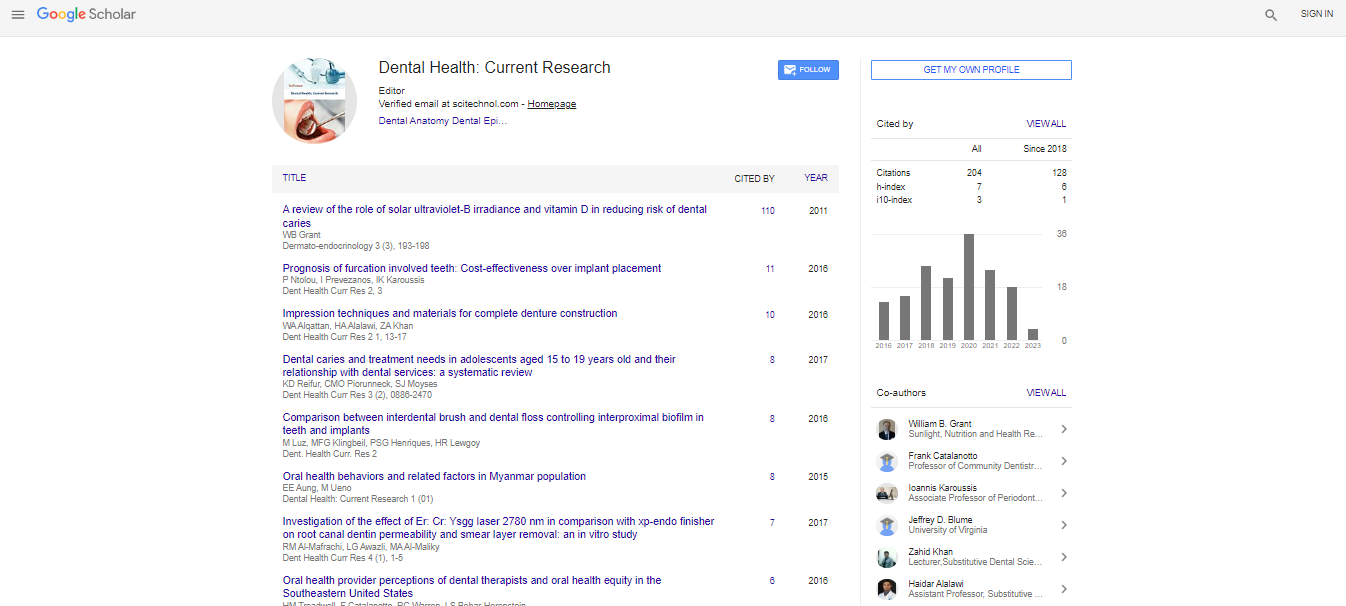The role of xylitol as a substation for fluoride in caries prevention
Majid I Aljadeed
PSMMC, Saudi Arabia
: Dent Health Curr Res
Abstract
Since the classical epidemiological studies by H. Trendley Dean, in1900s, Fluoride have been extensively employed to control dental caries. However, it has been known that there should be an optimum level of exposure to fluoride that would be able to provide the maximum protection against caries, with minimum dental fluorosis (Dean et al. 1942). It was believed that fluoride exerted its protective effect against caries through a â??systemicâ? action only. Therfore dental fluorosis was considered a necessary risk so that the cariostatic benefits of fluoride could be achieved (Buzalaf, Pessan, et al. 2011) However, The concept that fluoride interferes in the dynamics of caries formation mainly when it is constantly present at low concentrations in the fluid phases of the oral environment became broadly accepted (â??topicalâ? action) (ten Cate and Duijsters 1983; Ogaard et al. 1988; Ogaard et al. 1991; ten Cate and Featherstone 1991; Featherstone 2000). Effectiveness of fluoride supplements:In 1940s many paper related to the systemic fluoride supplements effects on caries prevention were published . According to Deni Survey 1946, Calcium fluoride tablets were found to reduce dental caries by 10 %, after a period of 6-8 months of use (1) , However this was contradicted by LARSEN (2), and confirmed by STONtis et al.(3) The studies most often quoted (4) in support of the effectiveness of fluoride tablets and drops in caries prevention were carried out in the 1960s and 1970s, before the wide availability of fluoridated dentifrices. In a survey in the Netherlands, conducted in 1979, the difference in caries prevalence between users and non-users of fluoride supplements did not remain statistically significant when differences in the socioeconomic status and toothbrushing habits between the users and non-users of fluoride tablets were considered. Dental fluorosis: The first to measure and report on the prevalence of dental fluorosis in users of fluoride supplements was done by ARNOLD et al. in 1960. It reported an increased prevalence of fluorosis in children who ingested fluoride supplements between birth and 6 year of age. The prevalence of fluorosis in the children examined was 12,1% if the questionable category of the Deanâ??s index of fluorosis Xylitol: Xylitol is a sugar alcohol used as a sweetener. The name derives from Ancient Greek: ξÏλον, xyl[on], â??woodâ? + suffix -itol, used to denote sugar alcohols. Xylitol is categorized as a polyalcohol or sugar alcohol. It has the formula CH2OH(CHOH)3CH2OH. It is a colorless or white solid that is soluble in water.(6) Industrial production starts from xylan, a hemicellulose, which is extracted from hardwoods or corncobs. These polymers can be hydrolyzed into xylose, which are catalytically hydrogenated into xylitol. The conversion changes the sugar (xylose, an aldehyde) into a primary alcohol (xylitol). (7) Xylitol has been used as a substitute for refined white sugar for more than 30 years, and is thought to have an inhibitory action on the major causative bacteria in dental caries, Streptococcus mutans (8) Xylitol has the ability to reduce lactic acid production in dental plaque, resulting in a higher plaque pH, therefore less cariogenic environment (9-10) Xylitol is a common ingredient in sugar-free tablets, chewing gum, dentifrice and oral rinses. It is a naturally occurring non-cariogenic sugar substitute that cannot be metabolized by oral bacteria. Dose:There is evidence that total daily doses of three to eight grams of xylitol are required for a clinical effect with the currently available delivery methods of syrup, chewing gum, and lozenges, However the dose should a minimum of two times a day without exceeding eight grams per day. (13-14)The American Academy of Pediatric Dentistry endorses the use ofxylitol as part of acomprehensive strategy to prevent caries but does not recommend xylitol toothpaste use because the research evidence is inconclusive. (15) There are several xylitol delivery modalities that In a study done in 2014 by Chi et al they concluded that brushing with low strength xylitol/Fluoride tooth paste has no effects on reducing early childhood caries in 4 to 5 year old children have been tested in young children, including gummy bears, syrup, and gum.(16-17) While a single in vitro study suggests that xylitol toothpastes have the potential to prevent tooth decay, clinical evidence is conflicting. (18-19) Clinical studies on xylitol toothpastes have focused on permanent teeth in older children, and no studies have tested xylitol toothpastes to prevent ECC. Another study done by Priya SuBraManiaM, n. nandan in 2011 concluded a significant reduction in plaque levels of S. mutans was observed with the use of xylitol, sodium fluoride and triclosan containing mouth rinse.(20) However in a recent study done in 2017 by Supatra Watthanasaen etal, concluded that daily use of xylitol chewing gum can reduce the rate of caries, increased remineralisation in the primary dentition, and improved oral hygiene of individuals with disabilities.(21) In contrary this study is, nevertheless, consistent with a study of 9- to 14-year-old schoolchildren in Lithuania23 which showed no difference in adjusted caries increment in the permanent dentition between 100% xylitol gum and no gum groups during the first 2 years of follow-up.(22) A systemic review done in 2012 titled Anticariogenic effect of xylitol versus fluoride â?? a quantitative systematic review of clinical trials, suggests that the addition of xylitol to existing ï¬?uoride regimes may be beneï¬cial in the prevention of caries. However, the current evidence is challenged by the high risk of systematic errorsâ?bias and confounder inï¬?uence. Thus, Future high-quality randomized controlled trials are needed to provide conclusive evidence on this topic. (23)
Biography
Dr. MAJID I. ALJADEED is working in the Department of Dentistry, PSMMC, AEGD, SAUDI ARABIA
 Spanish
Spanish  Chinese
Chinese  Russian
Russian  German
German  French
French  Japanese
Japanese  Portuguese
Portuguese  Hindi
Hindi 